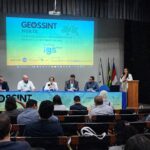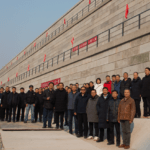
 Re-launched in March this year with a new board at the helm, the IGS Chile chapter hasn’t wasted time in putting on events, raising awareness and creating stronger links in the industry.
Re-launched in March this year with a new board at the helm, the IGS Chile chapter hasn’t wasted time in putting on events, raising awareness and creating stronger links in the industry.
Here, chapter president Francisco Pizarro gives an insight into the dynamic chapter and local marketplace.
Francisco, tell us a bit about your role.
“With the new board, we took on the challenge to relaunch the chapter about a year ago. I became president of the new board to help us realise our aims. Outside of that I am the Infrastructure Director for Propex Geosolutions, a US firm that is a leader in the engineering and manufacturing of geotextiles and high performance turf reinforcements mats (HPTRMs) for the erosion control market.”
How many members do you have and what is their make-up?
“Currently we have 10 corporate and more than 20 individual members. We have consultants, installers, manufacturers, engineering and construction companies, and are also looking forward to start working with academia and research institutions.”
What are you proud of in the chapter?
“The chapter was formed in 2006 but had no activity for almost 12 years until the new board took command and gave it more strength. In less than a year we’ve re-launched the chapter, transformed the institution’s place in the market and frequently organized technical events, such as workshops and talks, every month. Information from our monthly technical conferences is also uploaded to our website for members to access and share – www.igschile.org.”
What is coming up for the chapter?
“We have elections this month (Sept) in order to give transparency and sustainability to all the efforts made so far. We also have an Educate the Educators event in March 2020 and the Chilean Geosynthetics Congress is due to be held in 2020. We also recently hosted IGS Vice President Dr Nathalie Touze when she gave the 6th Giroud Lecture to chapter members last month (Aug).”
How would you describe the level of adoption and understanding about geosynthetics in Chile?
“There is still a lot of space to grow. Separation is a big market due to the mining industry (tailing dams, ponds etc), nevertheless other applications (stabilization, erosion control, filtration and drainage) still have a wide potential for growth.
Geosynthetics are not widely spread in the market versus traditional solutions like concrete, so I think there are great opportunities to come.”
Where are the areas of most opportunity?
“We need to improve the current specifications for geosynthetics. This has a direct relation in the industries where geosynthetics can be applied. The mining industry will still be the main market (in separation), nevertheless we need to broaden the range in stabilization, for example the use of geogrids and geocells in order to reduce the thickness of the aggregate base layer or the use of geocomposites in landfills or waste management. These are just few examples of many applications where geosynthetics can have a starring role.”
What does the industry need to do to grow the market?
“It’s a challenge with many dimensions but we can start with civil engineers and their related professionals. They need to add geosynthetics to their scope of learning so the technical gap can slowly start to reduce. Then we can also work with suppliers so they can demonstrate their solutions are robust enough to cope with all the technical necessities of the market.”
What is it like for the rest of South America? What are the opportunities?
“The question gives us the chance to thank the chapters of Brazil and Peru. Both have supported our growth and have been tremendously generous sharing their experiences with us. Notwithstanding there are chapters more robust than others, all countries share the fact that there’s still many opportunities of growth in the adoption of geosynthetics in the engineering and construction industry. No matter if it is for separation, reinforcement or filtration, all countries share the same potential for growth. It’s intrinsically related to the gap in infrastructure that still exists in the region.”
Where is the geosynthetics industry concentrated in Chile?
“In the north where the biggest copper mining and lithium projects are located. This means tailing dams and evaporation ponds that need to be isolated from the soil to secure impermeability. This brings great opportunity for geomembrane, Geosynthetic Clay Liner and related manufacturers.”
What does the future hold for geosynthetics use in Chile?
“There are still great opportunities for growth. Fortunately the market (companies, academia, regulators) is eager for more knowledge so that gives us great space to grow.”
South America will be in the spotlight at GeoAmericas 2020, which runs from April 26 to 29 at the Windsor Expo Convention Center, Rio de Janeiro, Brazil. To find out more about the conference, visit the dedicated show website at www.geoamericas2020.com.






















